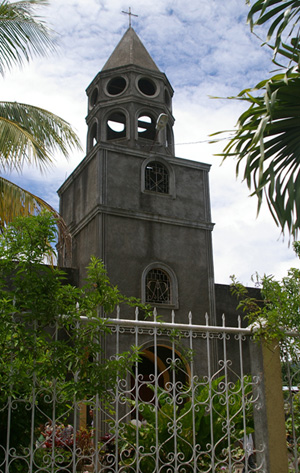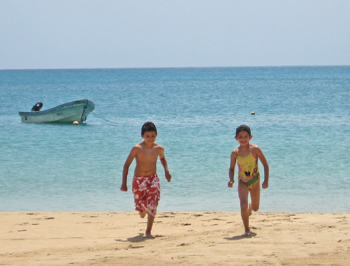NICARAGUA - THINGS TO DO - PAGE TWO

East of Managua: Boaco, Chantales and Juigalpa
East of Managua is unlike Nicaragua's other regions. Less volcanic than the northwest, drier than the south and more open and more accessible then the deep mountain areas. The area of Boaco and Chantales is dominated by cattle ranches. More than 60 percent of Nicaragua's dairy products originate from the east side of Lake Cocibolca. Spend two or three days here and you may be convinced that there's more to Nicaragua than meets the eye. You could easily spend a day in towns like Boaco or spend a day horseback riding at San José de los Remates.
A must see is one of Boaco's picturesque mountain villages such as Santa Lucía which is rife with gorgeous mountains and river valleys. Santa Lucía was founded in 1904 and is well situated, this mountain village is highlighted by it's surrounding lush valley and green mountains. The picture to the right is the Chuch of Santa Lucía.
The last big city on the road southeast to El Rama is Juigalpa which means Great City in Aztec. It is a prosperous city of cattle ranchers and farmers. One of the town's most interesting attractions is the Museo Arqueológico Gregorio Aguilar Barea, an airplane-hangar-like building housing a collection of more than a hundred examples of pre-Colombian statuary. The statues, thought to be 1,000 years old, were the work of the Chontal people, driven to the east side of Lake Cocibolca by the more powerful Nicaroas some 1500 years ago. Another place to visit is the Parque Palo Solo which has a view which is unforgettable and unsurpassed in the region.
The Atlantic Coast
East from Juigalpa you'll find the town of El Rama which straddles the frontier between the Atlantic and Pacific. El Rama is a port town on the shores of the Escondido and Mico Rivers. From here you can travel by boat or bus to the Atlantic Coast. The Atlantic coast of Nicaragua was originally populated primarily by the Miskito, Mayangna and Rama people. In the 1600s, English and Dutch pirates preyed on Spanish ships docked in the area. From a notorious Dutch pirate named Abraham Blauvelt (whose name in English, translates to Bluefields) is how the bay and the coastal city got it's name. Bluefields is a rich waterfront melting pot and it's principal attraction is it's Caribbean vibe. The music of choice in Bluefields area is Reggae. Bluefield's red-roofed Moravian Church built in 1848, was the first of its kind in Central America. Its design is reminiscent of New Orleans during the 1800s. The Palo de Mayo Festival is a month long party held every May. The entire month is a burst of colors, parades, feasting and dancing around the Maypole.
North of Bluefields is Pearl Lagoon, a quiet Caribbean community. This waterside village begs to be explored. Of interest is the iron cannon which is embossed with the seal of the lion and unicorn, a symbol of the British Empire. Activities in town include fishing, snorkeling trips, boating and horseback riding. Another way to get to Pearl Lagoon is through the Río Escondido, a beautiful boat ride north through a complex network of waterways which allow you to sail passed several shipwrecks. From Pearl Lagoon, hire a boat and enjoy a ride through the harbor, into the open Caribbean and up through the coastline of Pearl Cays. The Pearl Cays includes 18 beautiful deserted islands, most of them still untouched and accessible. The cays do not have any tourist facilities so be sure to bring plenty of drinking water, some first-aid supplies and snorkel gear. If you plan to stay the night on one of the islands, be sure to bring a hammock and make sure to pay your boatman when he picks you up and not when he drops you off.

Eighty-three kilometers due east of Bluefields, the Corn Islands are a pair of small Caribbean islands, known as Big Corn and Little Corn. Here you'll find a taste of Eden. In Big Corn there are a number of hotels and restaurants that cater to tourist. The fastest way to get to Big Corn is to fly. At Managua's international airport La Costeña offers daily flights. Big Corn Island offers beautiful stretches of beaches, the best being, Picnic Center Beach, an uninterrupted crescent of white-sand. The water here is clear turquoise blue characteristic of the Caribbean. Corn Islands offer three distinct layers of coral reefs which makes for impressing snorkeling and scuba diving. However, you'll need to brush up on your Creole because Spanish is the secondary language spoken on the islands. Hire a taxi for a full tour of Big Corn or catch a panga boat in order to spend a couple of days at Little Corn Island. Boats depart for Little Corn twice a day and the ride is often choppy and rough.
Continue...
